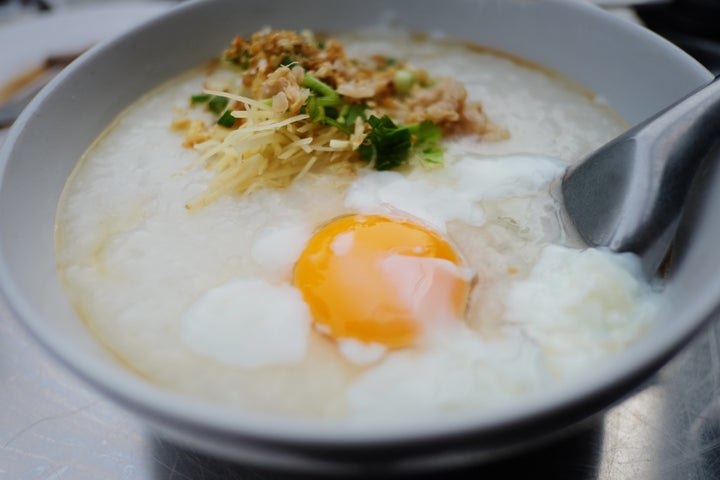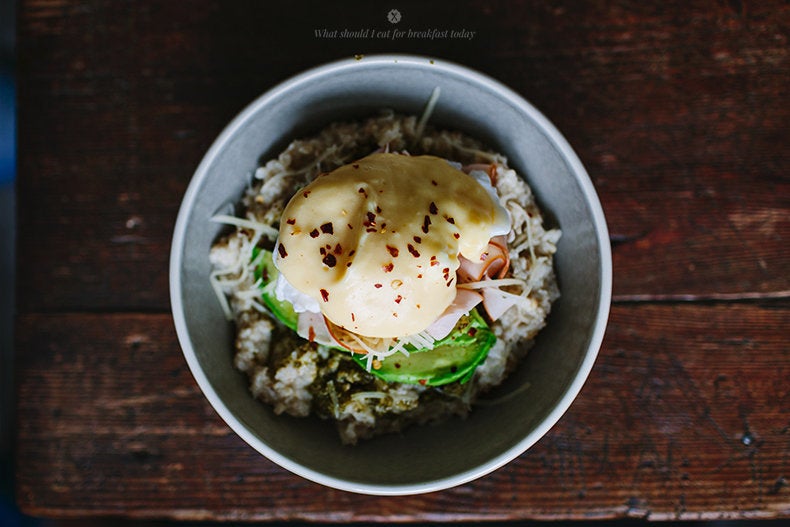Congee, in its most basic form, is just rice that’s been broken down with water or broth. But it also has the ability to break down cultural barriers, acting as a gateway to new ways of thinking about the way we eat, how to stretch a dollar and find something comforting for breakfast.
In Asian countries and Chinese culture in particular, rice boiled down with water is called jook or in English, congee. It’s often made as a savory breakfast option rather than with sugar and milk, like most porridges and oats in the States and Europe.
But this has begun to change, as congee has taken a turn from the blandest food you’ll ever love to a budding star, featured in articles across the internet. Congee now features wellness ingredients, fancy toppings and heritage grains. But before it became a trendy grain bowl, congee was a basic porridge, sustaining populations through many dynasties.
Congee is, and always has been, an easy way to stretch a dollar, making food last when there isn’t so much of it. And in most traditional recipes, it uses a minuscule amount of rice compared to water. The ratio of rice to water or broth can be anywhere from 1:5 to 1:8, meaning you can use very little to produce a large amount of food.
As a traditional comfort food, rice porridge has had an important place in Chinese food culture for centuries. Historically speaking, congee was served for breakfast or a healing food for the sick, the young and the elderly. With its supposed healing properties and smooth consistency, it is also often the first thing fed to babies.
But before it became trendy, congee was breakfast to generations of Chinese people growing up all over the world. And for Chinese-Americans, congee has been a familiar breakfast item, served up at many a family’s breakfast table.
I recall my own mother adding 2/3 cup of rice to a slow cooker, then filling it up the rest of the way with water to cook overnight. The next morning, an array of dishes like pickled veggies, scrambled eggs and leftovers from the night before, would pop up next to my bowl of congee. This, it seems, is a common memory.
Pastry chef Pamela Yung, who identifies as Chinese-American, remembers her congee growing up as “white plain soupy rice, with a few peanuts.” She described to HuffPost that on visits to her grandparents’ house in Chinatown, her father would “come in from his early morning walk. That’s when I knew I’d wake up to a bowl of hot congee and fried crullers. So, in that way, congee was my wake-up call.”

Jenny Dorsey, a Chinese-American chef and consultant who explores the Asian-American experience, told HuffPost that she also grew up eating congee and for her, “it was always all about the toppings.” At restaurants, she would also have the fried crullers Yung remembers but at home, toppings were also pretty traditional and simple. Like my own mother, hers would make a variety of pickled vegetables, from cucumbers to wood ear mushrooms, to go alongside their morning congee. A few of her favorite toppings are representative of the most traditional and common toppings one would see at restaurants serving congee, such as sliced fish or pork floss. Yung also describes similar breakfasts of congee and “a few fish cakes or slices of fish that could happily land in your bowl.”
Perhaps the most iconic type of Chinese congee, the one that is on most restaurant menus and is one of Dorsey’s favorites, is salted pork and preserved egg congee. This traditional favorite is served off of dim sum carts, in congee restaurants and, most often, for breakfast. It features ground pork and preserved egg, also known as century egg. The century egg gets its name from being fermented (usually for a few months) and darkens during its aging process, when it’s soaked in ash, among other ingredients.
But the century egg is something familiar to generations of Chinese and Chinese-Americans who ate it for snacks and, of course, on top of their morning congee. Its yolk is slightly firmer than a simple, boiled egg, and the “white,” which is now a translucent brown-gray, is savory without being overly salted. Its texture is a perfect foil to salty, chewy, ground pork in a smooth congee. While often seen as a “bizarre food,” it is, for many, breakfast.
Dorsey recalls her mother’s congee being made with rice and water. But her grandparents would often make it with a mixture of millet and water to “stretch rice farther,” as millet was cheaper. As she notes, “millet was cheaper before it became cool ― an example of a random Asian ingredient falling into white hands” and becoming trendy. And this has become an important part in why congee may be wading its way into the mainstream now. Congee indulges many of our current food trends, from a new interest in heritage grains, an embrace of broth culture and our love of “putting an egg on it.”
Yung and a few collaborators decided to take advantage of congee’s renewed popularity with their pop-up project, Congee Queens, originally conceived by Yung, Tara Norvell, Katy Peetz and Danny Newberg.
Yung told HuffPost that Congee Queens was realized “within weeks of Trump taking office, and we, as women in this country who naively thought our rights would somehow be protected, felt vulnerable and threatened. Cooking for a purpose clearly was the right thing to do. We were cooking a humble dish that transcends cultural boundaries, using our own imaginative take on it, and for an affordable price, to a lot of people. And, we donated the majority of our proceeds to Planned Parenthood.”
In an interview with Munchies, Norvell explained, “congee has not really been interpreted in America and I want to make it American.” Yung agreed and explained that congee is “comfort food that we all enjoy immensely.” Their project expands, like rice does in water, our traditional notions of food systems and what congee is.
Yung told HuffPost, “We didn’t really use traditional toppings; instead, we used top-notch market ingredients” and tried to “remain true to the original spirit and [flavor] profile of [congee].”
In speaking to these Chinese-American chefs who also grew up eating congee, it’s easy to see how individual yet universal congee really is. Congee has always been a simple base, a springboard to making something that is yours. It’s homey, comforting and shaped by family. And, like Congee Queens, this rice porridge finds beauty in “sharing food experiences rooted in love” while celebrating difference in its toppings.
